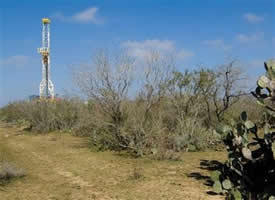Tuesday, May 20th, 2014 and is filed under Oil and Gas Current Events, Texas Oil and Gas Investing
 Back in the primordial times of 2010, the Eagle Ford Shale formation had an output of 55,000 barrels per day of crude oil and condensate. That volume shot to 1.36 million barrels per day in April 2014 and will soon hit 1.5 million. That rapid production spike is reshaping the South Texas economy.
Back in the primordial times of 2010, the Eagle Ford Shale formation had an output of 55,000 barrels per day of crude oil and condensate. That volume shot to 1.36 million barrels per day in April 2014 and will soon hit 1.5 million. That rapid production spike is reshaping the South Texas economy.
It’s this kind of economic dynamism that is breeding optimism among Mexican officials. The Eagle Ford shale formation is believed to stretch hundreds of miles into Mexico. The nation’s shale gas reserves are estimated to be the world’s sixth largest after China, Argentina, Algeria, the U.S., and Canada.
In South Texas there’s brisk demand for skilled workers including welders, pipefitters, computer numerical control lathe operators, and quality control technicians. The manufacturing sector is exploding. This according to a study by the Texas A&M Engineering Extension Service (TEEX) in cooperation with the U.S. Economic Development Administration.
The Eagle Ford shale boom’s shock wave is reverberating beyond the Lone Star State’s borders. Across the U.S. trucking companies are reeling from a driver shortage as truckers flock to South Texas, lured by $5,000 signing bonuses to haul sand, gravel, water, pipe, and other materials needed at drilling sites.
One hundred miles away, the Eagle Ford shale boom is driving a massive construction surge in Corpus Christi. In April 2014, the Austrian steel giant Voestalpine broke ground in the coastal city on a new billion-dollar iron ore plant—the largest foreign investment in the history of the firm. Beginning operations in early 2016, the plant will have a production capacity of some 2 million tons of hot briquetted iron.
RELATED >> Eagle Ford Shale Fuels Corpus Christi Boom
The gush of low density, low sulfur Eagle Ford crude is overwhelming the city’s refineries (two of the three refineries were designed to process thick, high-sulfur crude), consumed all available dock capacity, and is triggering a wave of new dock construction.
While the U.S. and Canada are developing their shale resources on a massive scale, those in Mexico languish. More than 5,400 wells have been sunk on the Texas side of Eagle Ford since 2008, while Mexico has attempted fewer than 25.
That’s why last December the General Congress of the United Mexican States approved a landmark energy bill. The measure will open up Mexico’s petroleum industry to private and foreign investment for the first time in 75 years. It was drafted with the intent of injecting Pemex, Mexico’s state-owned petroleum monopoly, with the new technology, expertise, and risk-taking culture it has long lacked.
Pemex estimates that the nation’s shale formations hold the energy equivalent of 60 billion barrels of oil—more than the entire volume Mexico has extracted via conventional means since 1904. Total untapped Mexican oil reserves are estimated to be worth at least $11 trillion, more than any Latin American nation, save for Venezuela and Brazil.
But will the U.S. and other firms who have poured into South Texas cross the border into Mexico? Development of Northern Mexico’s shale beds presents steep challenges. Dominated by smaller, nimble players, the shale development process is dependent on specialized equipment and services that must be deployed at precise moments in the drilling process. Mexico is utterly lacking in this network of technological resources. The area is also void of the pipelines, highways, shipping, power, and other infrastructure that spans across south Texas.
But these challenges may soon be overcome, conquered by the sheer immensity of Mexico’s resource potential.
RELATED >> Staging the Next Boom: Shale 2.0
RELATED >> Fracking Boom Driving Massive Industrialization in Louisiana
RELATED >> Oil boom means big money, big needs in south Texas
RELATED >> Permian Rising ~ Booming Energy Production Driving TX & NM Economies
Texas Oil & Gas Investment Opportunities
© Copyright 2024 Aresco, LP. All rights reserved. | Privacy Policy | Site by A3K Marketing. Admin Log in